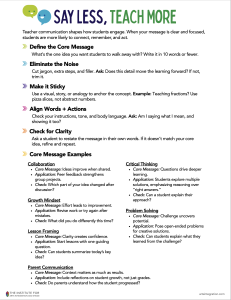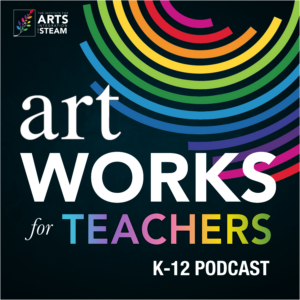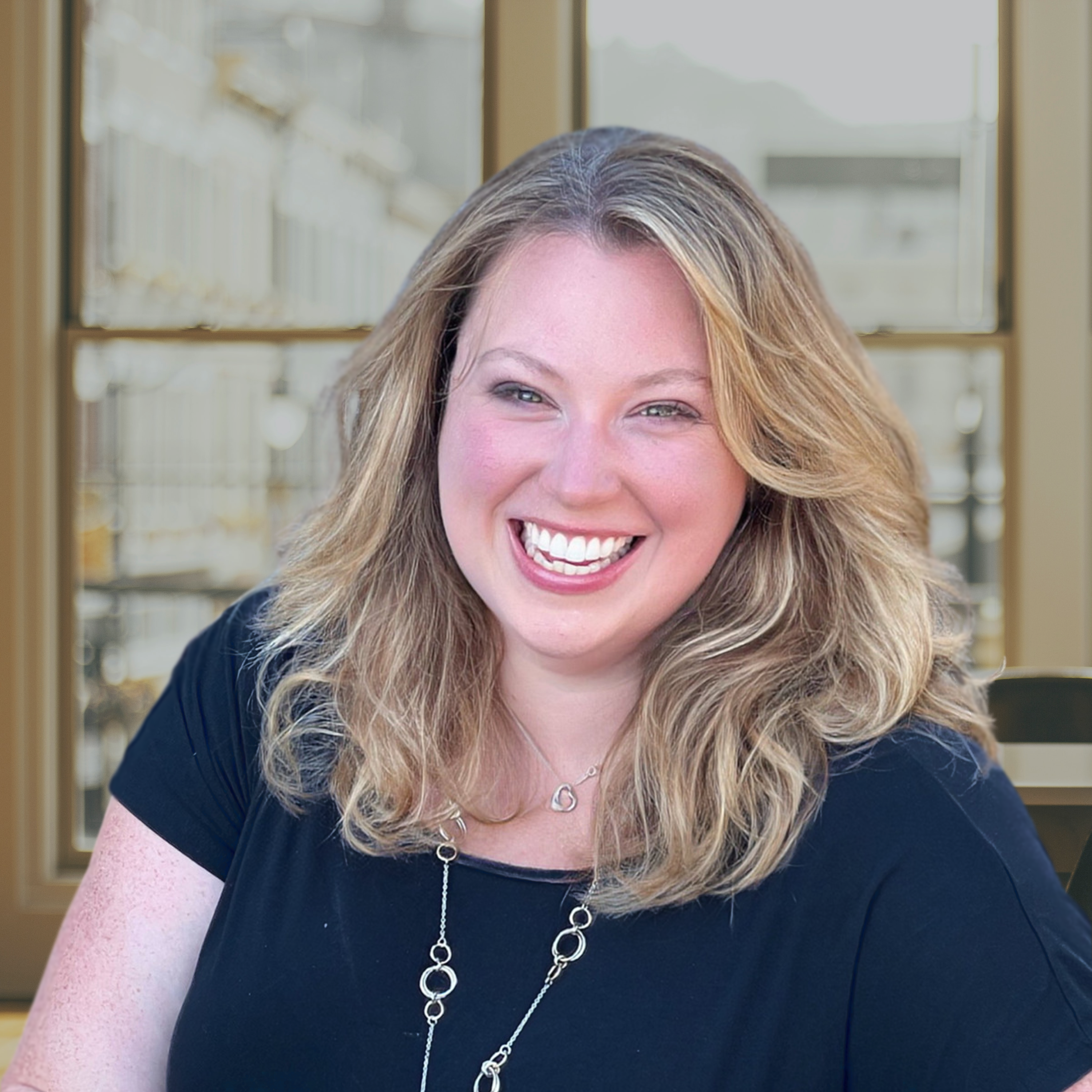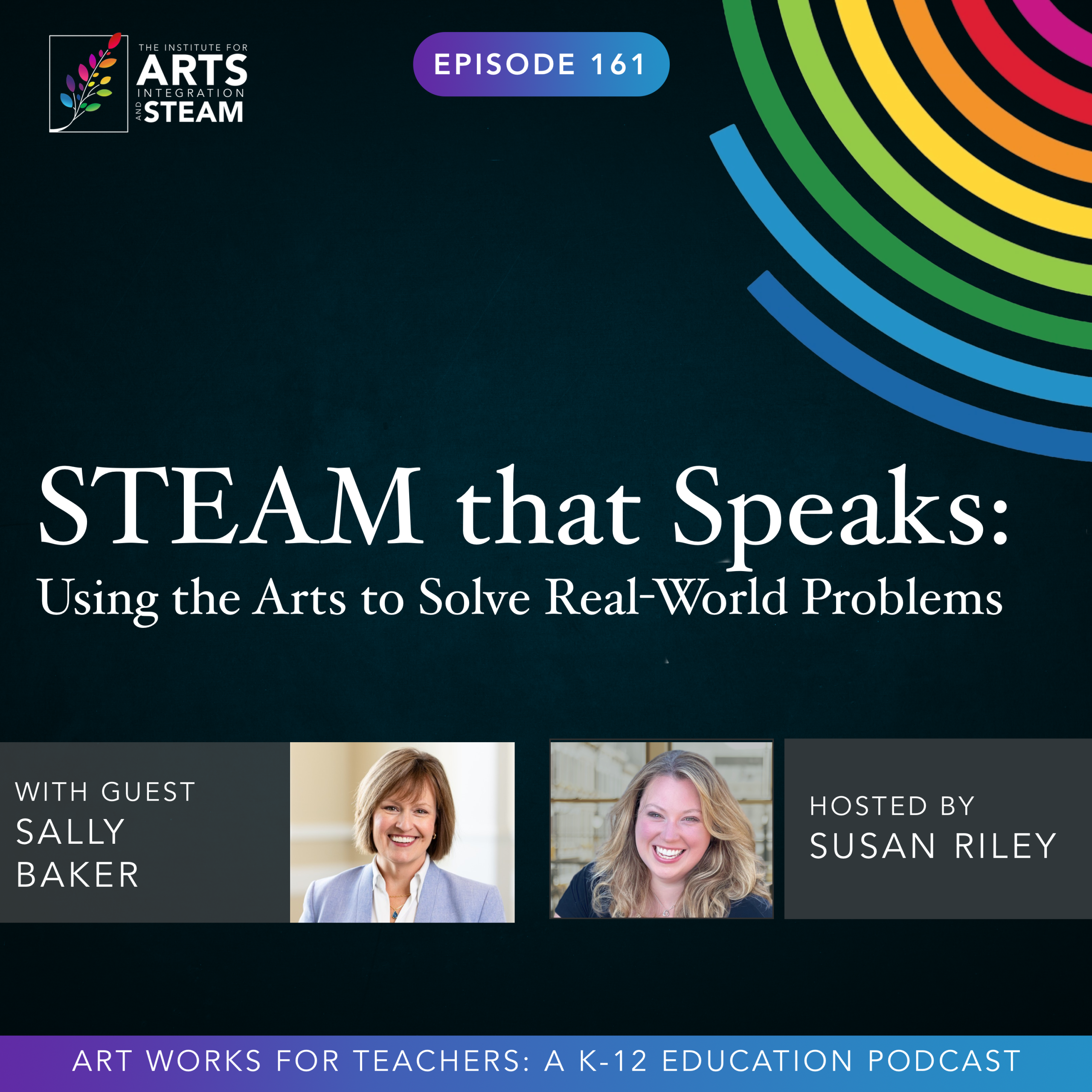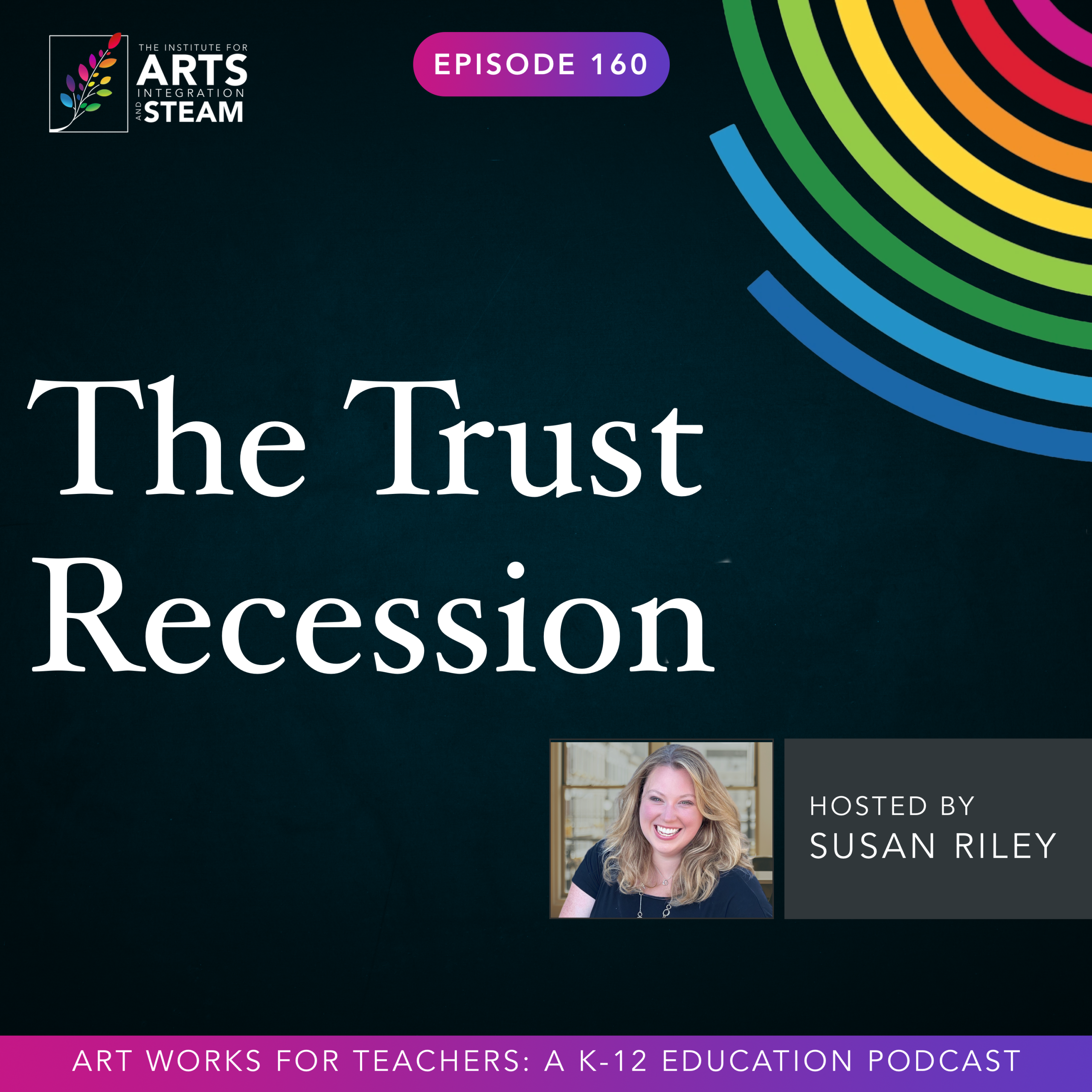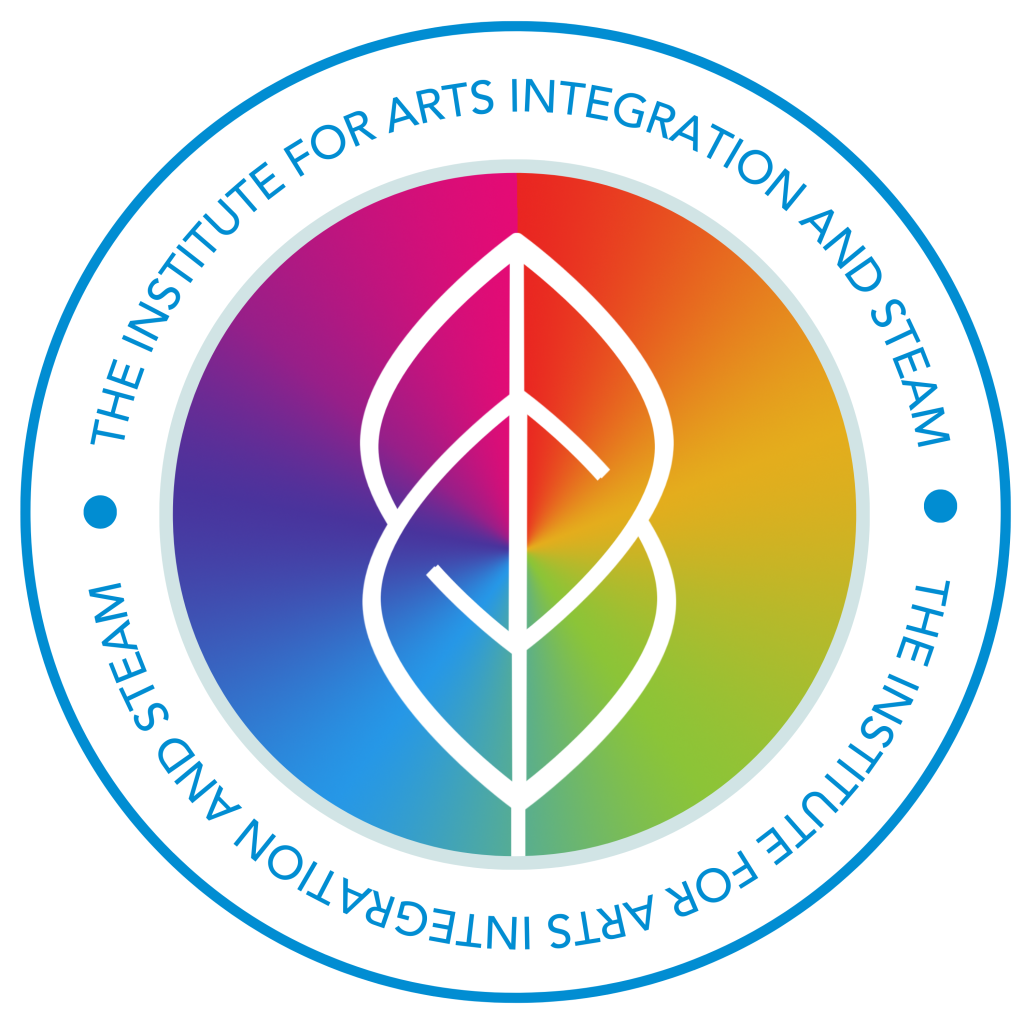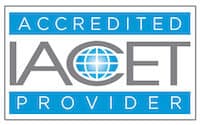ART WORKS FOR TEACHERS PODCAST | EPISODE 152 | 39:14 MIN
Every Day is a School Day
Enjoy this free download of the Talk Less, Teach More Resource.
Hey there, Paul, thank you so much for being on the show today.
Paul
It's an absolute pleasure, nice to meet you.
Susan
Wonderful, wonderful to meet you as well. For folks who may not know who you are, I would love for you to just share a little bit about yourself and this fascinating career that you've carved out for yourself between major leaders in the world and brands and creative organizations. I mean, you've kind of done it all. So I'd love to hear your journey.
Paul
Okay, so in a quick one, I've been in advertising all my life. I started out as a studio runner, just doing kind of things for the agency, making tea, kind of doing copy instructions. Then I graduated to be a copywriter. And then, you know, 10 years later, I was a creative director in an agency. Then I set my own agency up. And then I sold that agency to another agency. This happens a lot in agency, they all sell to each other.
And then they sold it to another agency group and I had a really great time there. And then I kind of worked for myself for a little while and then I joined another agency and now I'm working for myself again as a creative consultant. So all in the world of creativity, all in the world of commercial creativity. I mean, I think let's just be a very quick taster. So the kind of people that I have written on behalf of, because I'm a writer by trade, Tony Blair in the 1997 UK election, Bill Gates, when he was launching one of his books, and a guy called Bill Emmett, who was the editor of The Economist for over 10 years in the late 90s, early 2000s. And then brands that I've worked on range from Rolls-Royce, Microsoft, Ikea, the National Health Service, all doing lots of things, talking to lots of people in lots of different ways. So kind of… a real gamut of fostering creativity, being creative, selling creativity, you know, all those kinds of things that come together and it's, try to think of the connection with education. Every day is a school day in advertising. mean, that's the simplest way to describe it.
Susan
That's the best when you're working with copywriter friends, for those of you who don't know, it's the best. can just come up with a line like that. And I'm telling you, like, and now for our education friends who may not be aware, and I don't think if I had stayed in the classroom, I don't know that I would have been aware in the business world what a copywriter specifically does. And you're not just a copywriter. I know that you also craft strategy and creativity together and pull that as a thread, as a through line. So can you share a little bit for our educator friends the multitude of hats that you've worn? What is something like a copywriter? What do they do and how do they use creativity in that? And then how do they use that to develop strategy for creative endeavors?
Paul
Yeah, yeah, absolutely. That's a really good question. Thank you. So, copywriter is a person who writes words on behalf of brands and the people who are brands, if you like. So, you have to be able to get ideas across really simply and really quickly, but in the tone of the brand or person you're writing on behalf of.
And also you have to hit certain marks because we're in the selling game. So we have to sell something. The outcome is a sales inquiry or a change of mindset or a change of behavior. So every copywriter kind of has to do that. In the advertising agency world, a copywriter commonly works with an art director, their creative partner. You work as a team, you're two sides of the coin.
So the art director thinks mainly about the visual expressions of the story you're trying to tell. The copyrights mainly talk about the verbal, but because they're working together, that role sometimes switches. Now, ads don't come out of thin air. You don't just go, I'm going to do an ad for Ikea. What's this? You need a strategy. You need to know what the business strategy of Ikea is at that moment for this thing that they want you to sell. And you also then work out what the communication strategy is and the marketing strategy. it's kind of twofold. IKEA might want to sell more bedroom furniture. So that's great. That's the business strategy. The marketing strategy is we're going to sell to people who have growing kids because we've got a great product that expands and grows with them. And then the communication strategy is we're going to tell people about this in this way and we're going to hone in on this one point that we want to land. It might be, it saves you money over the lifetime of your child, or it might be your child will never complain about it if it's small or whatever. And that essentially is in the narrowest form is what we call strategy and advertising in business. That's called a tactic. So there's that kind of, it depends where you are operating as to what's the strategy and what's the tactic.
But in advertising, the strategy goes down to what you're trying to say. And then the creative team, mainly the copyright and the art director, but lots of other people around them, designers, directors, production people, illustrators, photographers, AI, you know, all do that stuff. So that's how it all works together in the world of advertising. Now, copywriting is a much broader church than that.
You can be a stalled copywriter on your own. You can be telling a company's story in many different ways. Copywriters help people write for business internally, as well as to customers. And it's a great job, you know, and it's vital because verbal communication in the form of the written word is important. Copywriters also write scripts for radio, or for TV ads, or for obviously on YouTube or whatever. So it's just the use of words and the way language works to convince people of something else. So there's a conviction thing in there that's really important.
Susan
Yeah, yeah, when I've worked with copywriters in the past, the things that I have really loved about working with copywriters is that they provide clarity around an idea that maybe you've been working with and you've been so close to and the copywriter sees it maybe from a different angle or can understand all of the stuff that you're talking about and just concisely and can condense it into a single brilliant idea. And for those of you who are feeling like,
sales, yucky, like it's not that, it's transformative. It's helping you see it from a different angle than maybe you've seen something before. And yes, no, it's okay. But also the strategy idea and our audience of educators might be thinking, this is fascinating, but how does this work with schools? I often think that if schools could communicate much more clearly and succinctly what it is that they're trying to do and why they're trying to do it. I think that you could change a whole lot of the things that are wrong in education right now just because people get stuck in the dialogue, they get stuck in the weeds, and they don't have a means, a strategy for moving the needle the way that they wanna move it. So I often think, man, if a school had access to a copywriter and a strategist who understood what it is you're trying to do, that can help push that idea into action. What are some ways that you've been able to kind of do that with other organizations that you've worked with? How do you help people push their idea into an actual action?
Paul
Okay, there's two things there. So I just want to rewind a little bit. So I totally agree with you that it's about clarity, but it's about kind of distillation and concentration as well, taking it down to one thing. So there's an old kind of advertising kind of truth where we say, clients may want to go, we say these three things about our product.
And you go, well, look, if I throw you three oranges, you might not catch one of them. If I throw you one, you're definitely going to catch it. So let's just say the one thing that's the most important. So that's kind of that distillation thing. And then the clarity thing is great. I would advertising man called David Ogilvie, famous agency called Ogilvie unsurprisingly. And he always had this maxim, which was people who think well, write well. And that's the virtuous circle. So people who write well, think well. People who think well, write well. It kind of becomes self kind of perpetuating. And then that is super important to apply to yourself. I think most education professionals can write well, but they get stuck in the tropes of the world that they're in and almost forget that they're talking to another person like them. And there's this kind of framework and this language and this, yeah, it just becomes atrophied and the language doesn't live and it doesn't then sell your idea. So I think that that's really important. And then the things that you can bring to the way you communicate as an educator not necessarily to your students in some ways but mainly to your stakeholders and I think you know we'll probably talk a little bit more about who your yes your stakeholders are students, also the students parents and they're also your peers and they're also the governors and the school board and the you know all funding budgets all of that stuff you've got to be able to communicate clearly with them and the the way to do that is to do it with someone.
You might be the person writing the words, but if you do it together and if you can get someone or now in the age of AI something to be those stakeholders, to wear those hats for you and you go, well, if I said this to you and you're a board, a school governor, how would you react to that? What if I said it in a different way to you? And then you've got to go through and this is the bit.
It's a bit of hard work. You're going to what if I said it in this way? What if I said it in this way? What if I said it in this way? Now, I like to use prompts into my chosen AI platform to give me different ways. And you brief it like you would brief a copywriter or a colleague. And you get options. And then you use your judgment as an expert in the field and as a human being who can write which one's working for you. AI doesn't write anything for you. Let's stick that into the bin, right? But it does really help you kind of face down the tyranny of the blank screen. And it's a colleague, not a crutch, not a threat. It's a colleague. And I love
Susan
Yeah, I like this idea of using AI as that partner. I think, first of all, I want to roll back a little bit when you talked about working with an art director and being able to, in an arts integration, that's what we do, right? A classroom teacher is going to work with an arts teacher and those ideas synergize together. And I think that plays out beautifully in the real world and what you're working with. I think your idea of using AI though as the third party, Dan Pink calls it the third chair. The chair that is empty, that is the one that you're trying to convince. So whether a teacher is trying to convince a principal to bring more arts into the classroom or to allow more creativity or innovation to happen to the school. Or if an administrator is trying to convince a board member, like we need more funding for this using AI as that person and being able to say, want to convince that person, if I said it this way, this way, with this way, or what are some ideas that would prompt that so that you could start to refine and really narrow in on the thing that's going to make the difference. I think that's a brilliant way to use AI.
Paul
Yeah. And it allows you to, know, if you're not great at empathy, weirdly it allows you to generate empathy because you can put as many different characters with different agendas and different biases, different kind of outcomes that they want to see in that chair. you know, strategy and creativity is that beautiful combination of, you know, thinking, feeling and doing, head, heart, hands, intelligence, empathy, craft, whatever set of three you like to use, that is where it comes together beautifully and in a way that motivates people to be part of your story. So one of the things I do in my professional life is
When I've got a challenge and they go, you're the creative and strategic guy, you solve that challenge. The first thing I say is no, we're going to solve that challenge. It's your challenge. You have to retain ownership of it. I'm the person helping you do that. So I won't take something away and do it and come back days or weeks later going, haha, done. I go, let's do this together. Let's sit down and people are so much more invested and they feel so much more responsible for the idea. It's easy to kill an idea if you've not been part of its inception. If you'd be part of that story, what usually ends up is you don't want to kill any of your ideas and then it's up to a professional who's been used to killing their own ideas and having their ideas killed for 35 years. He's quite happy to do it, you know.
I would say out of every hundred ideas I have, 1990 killed. And out of every idea that goes forward, only one of those out of a hundred actually really has any effect. That's the success rate you're looking at.
Susan
Yeah, yeah. Well, so when you're working with these groups and you're doing these rapid idea kind of generation or rebranding projects, what have you, what are some of the creative problem solving tools that you use that maybe educators could use in the school setting?
Paul
Yeah, this is brilliant because I use kind of, kind of sector agnostic frameworks and tools. So I was very fortunate little bit of backstoring again, sorry. A few years ago, I did a masters in innovation, creativity and leadership, the only course of its kind in the world. And only a few hundred people have done it over 10 years of its life. you know, got an MSc, you know, really, I'm a scientist, right? I've got an MSc, that's fantastic. I'm not, please tell me, I'm absolutely not. But what I did learn was a set of tools and benign frameworks, benign structures that you could apply to anything, to any kind of idea generation and idea selection. I'm sure you your audience is completely aware of convergent and divergent thinking and the cycle of convergent thought. So the tools that I'd like to use are ones that support divergent thinking. So for example, brainstorm, everybody goes, brainstorm. But if you know how to do a brainstorm and how to manage one, you know, it takes training and it takes experience, then they're really effective and using them at the right time brainstorming. There's a lovely one called brain writing because if you're a more introverted person and if you like to consider stuff and if you don't like the hurly burly of a brainstorm where people are kind of right, know, throwing stuff on the wall, you might get the brief and write for 10 minutes your response to that. That's brain writing. That's really good. That goes up as part of collective. There's a thing called imagery safari where you kind of sketch or you find things that you can print out and put on the wall to kind of find space that you want to occupy. I mean, that's brilliant in a classroom setting as much as it is in a of storytelling setting. There's a brilliant technique called Scamper, which is an acronym for substitute, combine, adapt, modify, eliminate, and reverse, which is a way of remixing your idea but within a structure, is really, that's really useful. You can use that for anything. And then if you're kind of doing something slightly more complicated or, you know, several steps, we like to do desktop walkthroughs, which is using, you know, Lego modeling clay, bits of cardboard, then you actually make it a physical thing. So that experience that is normally a kind of passive on-screen semi-intellectual thing becomes physical feeling thing and it brings it to life for people. So that's some divergent ideas. Now you have those divergent ideas and then you have that kind of period of reflection where you judge or you just think about them and then you start to converge, you start to hone the ideas down into a pointy bit. So it might be a technique called selecting hits, which is just basically your first pass and you put little dots on the ideas you like.
Then there might be some criteria setting. So why did you choose that? And then you can build up a matrix of criteria. It becomes a little bit more kind of methodical. And then you build an evaluation matrix off those criteria. So now you're building a story from the loose, feel this is right, to the this is why it is right. And this is how it compares with the other ideas in a more measurable way. Then you get to some ideas and then use ALUA.
which is advantageous limitations, unique features and overcoming limitations, right? So you're now getting into the integrity and you might then get down to a technique that I like called paired comparison analysis, which is just setting your ideas off each other on a matrix. So you start off all kind of, oh, every idea is valid, blah, blah, blah. And then you kind of get to this is the killer idea. But that's the start of it because then you have to communicate the idea and that's where something else comes in. So you have this kind of space of idea generation and selection and having the idea is essentially not the end of the process but the beginning of another one.
Susan
Yeah, yeah, it's so cyclical in nature. And often I think that when we're open to creativity, the starting place is curiosity. And I know that you believe that as well. You've said that curiosity should be a core behavior and you've even got research around the connection between curiosity and creativity. Can you share a little bit of that with us?
Paul
I can, I can. So this was part of the masters that I did. I some new research, both quant and qual, into the relationship between curiosity and creativity. And I'm going to read from notes here because it was a little while ago and I just need to know that I've said the right thing. So. Previous research for academic research has shown that curiosity activates the dopamine pathways in you you're greater engaged with the subject. You you're more open to new things, right? That's essentially what curiosity is. That's the chemical that it triggers. So people who are described as curious also are more resilient to creative block. See, because they're open, they can find their way around the problem and they actually have greater divergent thinking.
So we just talked about divergent thinking and that is what curiosity is all about. Now, organizational openness and not just individual curiosity really matters. So employees have reported creativity with us when curiosity is stifled by culture or process. So the environment in which you're in and the way you go about things really strongly affects curiosity. When I did my survey, 86 % of people that I surveyed and they were professionals strongly or slightly agreed that curiosity and creativity feed each other. So again, it's a cycle. We talked about think clearly, right, clearly, think clearly, right, same thing, curious, creative, curious, creative, curious, creative. Because as soon as you're creative, it means that you're curious about where that creativity can go. And it kind of builds again. So it's that intrinsic drive to kind of seek and acquire and apply new knowledge. That's why curiosity is great. So that what if or why or how might this work difficult. So they are different things though, because creativity is the application of the knowledge of that curiosity engenders.
So they're not interchangeable and people do do that. And one of the pits of my research made that very clear to me that people initially saw curiosity and creativity as interchangeable. And both in the interviews that I held with people who ranged from a Cambridge professor of maths, a leading political economist, a former detective inspector on the terrorist squad, a musician and artist, all these people kind of were in the same space. It's really interesting, you even though their curiosity and their creativity looked different in the outset. From the inside, pretty much, pretty much the same. So the kind of real world implication of this is that creative problem solving begins with curiosity driven exploration. You can't expect to solve something using creative techniques like the ones we discussed or create people like this one in front of you without doing the exploration, without thinking, you know, looking into the issue and the people who face that issue and the people who could solve that issue always go back to the people. And, you know, in education, that's pretty much all of it.
And it's so weird that the structures overwhelm the people a lot of the time. The structured way of thinking, the structured way of behaving, the structured way of telling your story. And if you can use your curiosity to either bend that to your will, or if you're feeling really brave, break it completely. You know, that helps. As soon as you lose interest in something, as soon as your curiosity fades, you're not going to have creative solution because you're just not going to be emotionally involved with it. And curiosity is an emotional thing as much as is an intellectual thing. And I think, again, in the world of education where art needs to show its power beyond mere execution of art, that's curious part. know, creative people, engineers are creative people, scientists are creative people, know, administrators are creative people because they all have to solve a problem at some time. So how do we, in the more kind of arts-based execution of work, bring the way we think to every element of education and the way education works? Because it's not just about delivery.
It's about the framing of it. And that's the kind of problem solving as a long-standing advertising person that really attracts me because it's thorny and it's difficult and there's many facets to it. And the idea of being able to find one piece of kind of clear messaging that helps people take the next step, that's really exciting. And I'd love… for people in education to feel that.
Susan
Yeah, yeah, to get that excitement. there's a couple of things that were really powerful that you just said about the idea that structures overwhelm educators and the education system when really the whole point of everything is to be curious and open and to follow the through lines that you find and kind of discover something new and use that to create. think that sometimes we don't consider that we look so much at systematizing things that we forget that the whole point is to be curious, to explore new things. And you also just shared that when you lose creativity, that's when you've lost the student, right? So the student who loved math, but suddenly it became all about formulas and not about like, do these numbers interact this way? And instead, these are the harsh formulas they have to follow, suddenly their interest is gone, right? So I think so many gems that you just shared within there that we could unpack, but we're running short on time. But before I do that, I do wanna kind of come back and tie this together through this storytelling element that is your kind of home base. You know the power of storytelling. We all know the power of storytelling. We live through stories, right? We love them.
How might we be able to bring or borrow some of the storytelling elements or playbooks that you use to communicate what makes our schools unique and places where curiosity can thrive?
Paul
Yeah, that's really… Because it's different for everyone. mean, you know, the easy answer is it depends. But that's no use to you. I totally agree that everything is a story. know, ideas of any kind land better when they're told not tabulated. You know, that's everything from a financial review to a lesson plan, to a pitch for funding. All of these things need a beginning, a middle and an end. They need a hero. You might be the hero or the subject might be the hero or the student might be the hero. Okay. You need challenges and you need to overcome those challenges. You need some feeling of a journey, a journey of self-discovery, physical journey, all those kind of things. So I would recommend to people to look at, there's so much online, so many brilliant books, look at the structures for novel writing, for writing screenplays, for writing continuing series and apply them to your subject, apply them to your lesson, apply them to the you know, kind of the pitch for funding that you're doing, turn everything into a story. So let's put it into a social context. You're at someone's house. You've had dinner and they go, well, what are you working on at the moment? You will not say, oh, I'm doing this, this and this. They'll say, well, interesting. You should ask me that. So it started like this and then I did this and then you draw in the other characters and then you talk about something that happened. So you're telling that story and somehow brilliantly engaging story gets lost. But when you're into that, that kind of, okay, how do we get this thing done? Take that story and put it down. So one of the things that I used to do, if I've got a complex idea, was I pick my phone up and I would talk the story into my phone as if I'm having a conversation. Cause sometimes you get, and I get it, I'm, you know, I've written millions of words, but as soon as you hit that keyboard, or even hold the pencil in your hand, you stop. But you can freewheel with your phone. And then of course, it's just brilliant. All the tools can tidy that up and AI is brilliant for that. So it kind of helps you write your story even more. So by applying a story to your kind of latent idea, it makes it fuller, makes it stronger, it makes it longer lasting makes it more valuable to whoever you're trying to get to change their behavior. But I just want to say one thing, tone is important to your story as is the narrative, the words you use, the way you use the structure of the story you're telling. So you've got to think about your audience because that empathy, that's your empathy bit. Put yourself in their shoes, what would they like to hear? What would they not like to hear? Do not say it in that way.
And then people get hung up on originality and uniqueness and nothing's original. They're all standing on the shoulders of giants. Uniqueness is a really big ask. So in advertising, we talk less about originality and uniqueness and more about distinctiveness. How do we make this different?
So there's a guy called, if you want to get into this, there's a guy called Byron Sharp at the Arian de Bass Institute, may or may not have heard of him. He's done a lot of work on how brands work and how people react to them. Distinctiveness is what it comes down to. So you might be saying the same idea as someone else, but the way you do it, how you package it, how you present it, how you write about it, is what makes it a winner, or at least gets it to the next stage.
Susan
So true. And as a musician, you I always say you work with the same 12 notes, but there are bazillion different ways that you can work with those notes. So it's really up to you to make that distinctive to your point. Paul, I could continue to have this conversation with you all day. I think I'm learning so much. Thank you. But we are running out of time. So for those who would like to continue to learn from you, what's the best way for them to stay in contact?
Paul
So everyone can DM me through my LinkedIn. That's absolutely fine. Very shortly, there's going to be a substack. when you search, SNOXISHERE, S-N-O-X-I-S-H-E-R-E, search me for the substack for there. I've also got a white paper available about the research that we've just talked about. A nice and short one, nothing too onerous. And I can send that to anybody who requests it through LinkedIn or through your platform.
Susan
Fantastic, we will put all of those in the show notes and we'll make sure that we put that research there as well so everybody can find it very easily. Paul, thank you so much for joining me today. It has been such a pleasure to learn from you.
Paul
It's been a delight and I've learned from you too, which is great.
Susan
Thank you.
Paul on LinkedIn

